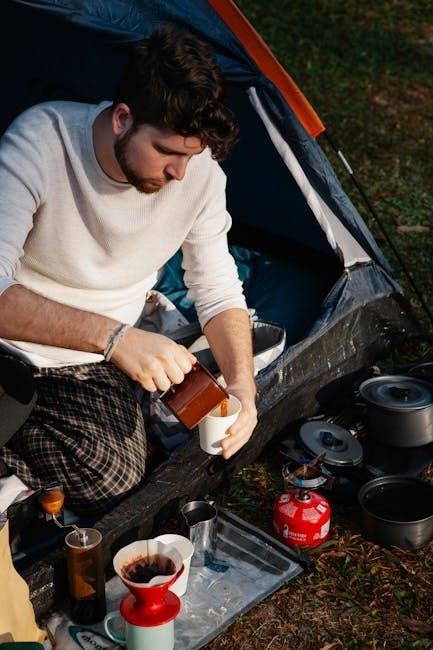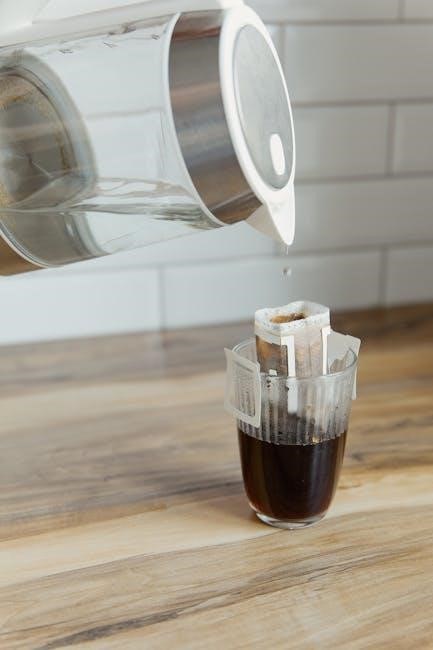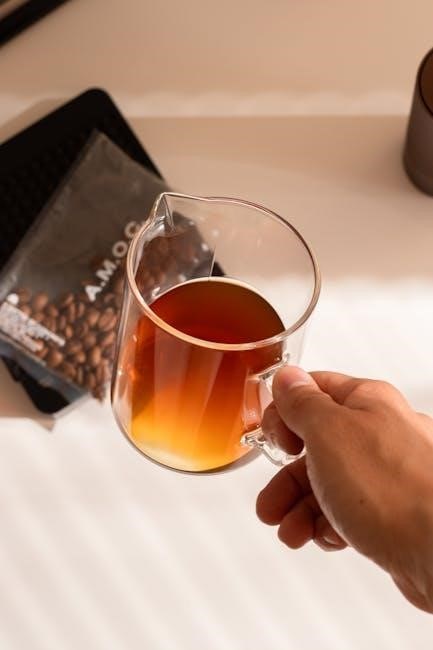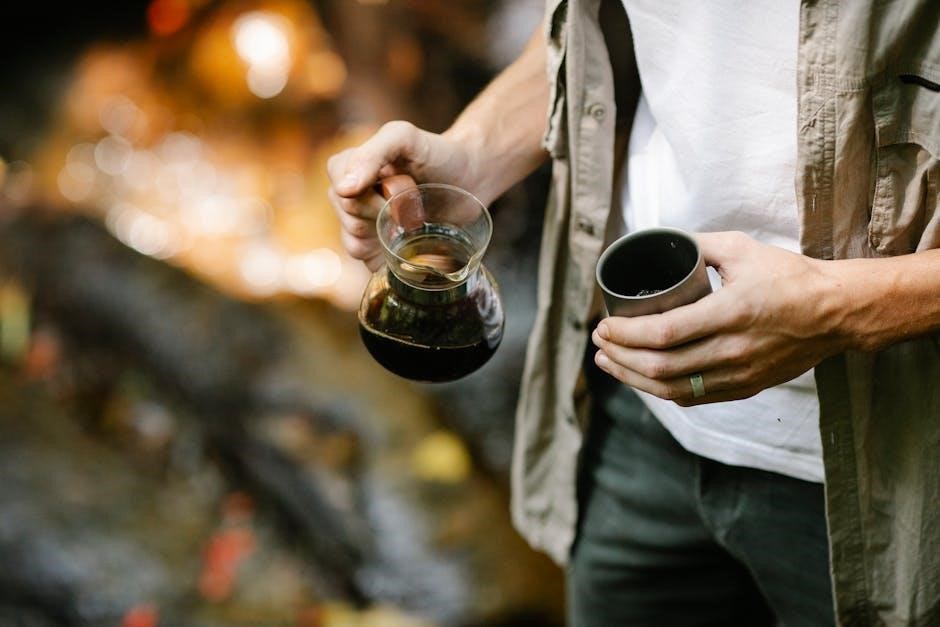Pour-over coffee is a manual brewing method using a dripper and filter, offering a clean, nuanced cup. It’s popular among enthusiasts for its control over flavor extraction and quality.
1.1 What is Pour-Over Coffee?
Pour-over coffee is a manual brewing method that involves slowly pouring hot water over ground coffee beans in a filter. It requires a dripper, filter, and a collection vessel. This technique allows for precise control over factors like coffee-to-water ratio, grind size, and water temperature, making it a favorite among coffee enthusiasts. The process results in a clean, nuanced, and flavorful cup that highlights the unique characteristics of the coffee beans. Unlike automatic brewers, pour-over coffee demands attention and skill, offering a more personal and customizable brewing experience. It’s particularly ideal for those who appreciate the art of coffee making and seek to bring out the best in their beans.
1.2 Benefits of Pour-Over Brewing
Pour-over brewing offers several advantages for coffee lovers. It provides exceptional control over brewing parameters, allowing for a highly customizable cup. The manual process ensures a clean and bright flavor profile, as it avoids the bitterness that can come from improper extraction in automatic brewers. Pour-over coffee is also praised for its ability to highlight the unique nuances of high-quality, specialty coffee beans. Additionally, it’s an eco-friendly method, as it eliminates the need for capsules or disposable filters. The ritualistic nature of pour-over brewing also makes it a meditative and enjoyable process for many. Overall, it’s a method that combines simplicity with sophistication, delivering a superior coffee experience for those willing to invest the time and effort.

Equipment Needed
Pour-over brewing requires essential tools like a pour-over brewer, filter, gooseneck kettle, coffee beans, grinder, and a mug. Optional accessories can enhance the brewing experience.
2.1 Essential Tools
To brew pour-over coffee, you’ll need a few essential tools. A pour-over brewer, such as a V60, Chemex, or Kalita Wave, is the cornerstone of the setup. Paper or metal filters are required to line the brewer and ensure a clean extraction. A gooseneck kettle is crucial for precise water control and even pouring. Fresh coffee beans are a must, and a grinder is necessary to achieve the ideal grind size. A scale helps measure the perfect coffee-to-water ratio, while a mug or carafe collects the brewed coffee. These tools work together to create a balanced and flavorful cup, allowing you to customize your brewing process to suit your taste preferences.
2.2 Optional Accessories
While essential tools are necessary for brewing pour-over coffee, optional accessories can enhance your experience. A timer helps monitor brewing time, ensuring optimal extraction. A coffee distribution tool, like a stirrer or leveling tool, ensures even saturation of grounds. Coffee syrups or creamers allow for customization of flavor post-brewing. A thermal carafe keeps coffee warm for extended periods. Storage containers preserve coffee beans’ freshness. These accessories, while not mandatory, can refine your pour-over process and elevate the quality of your brew.
Coffee Preparation
Coffee preparation involves selecting the right beans, grinding them, and ensuring the perfect coffee-to-water ratio for a balanced brew. Adjusting grind size and water quality enhances flavor properly.
3.1 Selecting the Right Coffee Beans
Selecting the right coffee beans is crucial for a perfect pour-over brew. Light to medium roast beans are ideal, as they highlight the coffee’s unique flavors and acidity. Opt for freshly roasted beans to ensure maximum freshness and aroma. Single-origin beans are recommended to experience distinct regional notes. Experiment with different origins, such as Ethiopian or Colombian, to find your preference. Store beans in an airtight container to preserve freshness. Avoid pre-ground beans, as they lose flavor quickly. Freshly roasted and ground coffee ensures a vibrant, balanced cup. Choose beans that align with your taste preferences, whether bright and fruity or smooth and nutty, to elevate your pour-over experience.
3.2 Grinding the Beans
Grinding the beans is a critical step in pour-over coffee brewing. The grind size plays a significant role in extraction, with a medium grind recommended for most pour-over methods. Start with a medium-coarse grind and adjust based on the flow of water and brew time. If the coffee brews too quickly, the grind may be too coarse, leading to under-extraction. Conversely, a grind that’s too fine can cause slow brewing and over-extraction, resulting in a bitter taste. Use a burr grinder for consistent results, as blade grinders can generate heat and inconsistently sized particles. Grind the beans just before brewing to ensure optimal flavor and aroma. Adjusting the grind size is key to achieving a balanced and flavorful cup of pour-over coffee.

The Brewing Process
Pour-over brewing involves manually pouring hot water over ground coffee beans in a filter, allowing precise control over temperature, ratio, and extraction for a balanced cup.
4.1 Step-by-Step Instructions
Place the filter in the dripper and rinse it with hot water to remove any paper taste. Discard the water. Add ground coffee, level it, and zero the scale.
Pour a small amount of water (about 40-50g) over the coffee to saturate the grounds. Let it bloom for 30-45 seconds to release CO2.
Slowly pour the remaining water (300-350g) in a circular motion, starting from the center and spiraling outward. Avoid pouring too quickly or allowing the water to flow unevenly.
Pause briefly if the water reaches the top of the filter to prevent overflow. Continue until all water is poured.
Allow the coffee to drip completely, then remove and discard the filter. Pour the coffee into your mug and serve immediately. This method ensures a clean, balanced brew.
4.2 The Blooming Phase
The blooming phase is a crucial step in pour-over brewing where hot water is initially poured over the coffee grounds to release trapped gases, particularly carbon dioxide. This process enhances flavor extraction by allowing the coffee to expand and evenly saturate. To bloom, pour a small amount of water (about 40-50g) over the grounds, ensuring all are saturated. Let it sit for 30-45 seconds. This step prevents channeling and ensures a balanced extraction. After blooming, proceed with the rest of the pour, maintaining a steady flow. The blooming phase sets the foundation for a clean and flavorful cup, making it essential for achieving optimal results in pour-over brewing.

Tips for Perfecting Your Technique
Adjusting grind size and monitoring water temperature are key to mastering pour-over. Fine-tune these elements to achieve a balanced extraction and a flavorful cup every time.
5.1 Adjusting Grind Size
Grind size plays a crucial role in pour-over coffee, as it directly impacts extraction. A medium grind is typically recommended, but this can vary depending on the equipment and desired flavor profile. If the grind is too coarse, water will flow through the coffee bed too quickly, leading to under-extraction and a weak cup. Conversely, a grind that’s too fine can slow down the brewing process, resulting in over-extraction and a bitter taste. Experiment by adjusting the grind size slightly and observing how it affects the flavor. Start with a medium grind and tweak it based on the results. This trial-and-error process is essential for achieving a perfectly balanced cup. Always ensure the grind is consistent for even extraction.
5.2 Monitoring Water Temperature
Water temperature is a critical factor in pour-over coffee, as it directly affects extraction. The ideal temperature for brewing is between 195°F and 205°F, just below boiling point. Water that’s too hot can burn the coffee, leading to a bitter taste, while water that’s too cool may result in under-extraction and a weak cup. Use a thermometer to monitor the temperature accurately. If you don’t have one, let the water sit for 30-45 seconds after boiling to cool slightly. Consistent temperature ensures even extraction and brings out the coffee’s optimal flavors. Adjust your kettle or pouring technique as needed to maintain this range for a balanced brew.
Common Mistakes to Avoid
Common mistakes include using the wrong grind size, incorrect water temperature, and uneven coffee distribution. These errors can lead to over- or under-extraction, affecting flavor quality.
6.1 Over-Extraction
Over-extraction occurs when too much coffee dissolves into the water, resulting in a bitter, unbalanced flavor. This happens if the grind is too fine, water temperature is too high, or brewing time is too long. To fix this, adjust the grind to a coarser size, reduce the water amount, or shorten the steeping time. Ensuring even saturation and proper drainage can also prevent over-extraction. Experimenting with these variables helps achieve a smoother, more enjoyable cup. Paying attention to these details is key to avoiding a bitter taste and preserving the coffee’s natural flavors.
6.2 Under-Extraction
Under-extraction occurs when the coffee doesn’t steep long enough, resulting in a weak, sour, or tea-like flavor. This is often due to a grind that’s too coarse, insufficient coffee grounds, or water passing through the bed too quickly. To address this, try using a slightly finer grind, increase the coffee-to-water ratio, or extend the brewing time. Ensuring even saturation of the grounds during the bloom phase and pouring in a steady, circular motion can also help. Proper water flow and drainage are critical to achieving balanced extraction. Adjusting these factors will enhance the flavor and prevent under-extraction, leading to a more satisfying cup of coffee.
Troubleshooting
Troubleshooting pour-over coffee involves identifying issues like under-extraction or over-extraction, adjusting grind size, and ensuring proper water temperature. Experimenting with ratios and bloom times can help achieve a balanced cup.
7.1 Diagnosing Flavor Issues
Diagnosing flavor issues in pour-over coffee starts with identifying under-extraction or over-extraction. Under-extracted coffee tastes sour or weak, often due to a coarse grind or insufficient brew time. Over-extracted coffee is bitter, usually from a fine grind or excessive water contact. Adjusting the grind size and water flow can resolve these imbalances. Additionally, bloom time and water temperature play crucial roles; uneven blooming or incorrect temperatures can lead to inconsistent extraction. Experimenting with ratios and pouring techniques can help pinpoint the root cause. By refining these variables, you can achieve a balanced and flavorful cup tailored to your preferences.
7.2 Solving Equipment Problems
Common equipment issues in pour-over brewing can hinder the perfect cup. A paper-like taste may indicate unripe filters—rinse thoroughly before use. If water flows too quickly, check for clogged filters or improperly ground beans. Drippers can become clogged with old coffee oils; clean them regularly with soap and water. Kettles with limescale buildup may affect water flow; descale periodically; Ensure your scale is calibrated for accurate measurements. If the filter collapses, adjust the coffee bed leveling. For consistent results, maintain your equipment and replace worn-out filters. Regular maintenance and proper care will ensure your pour-over setup performs optimally, delivering a flawless brewing experience every time.

Advanced Techniques
Experiment with coffee-to-water ratios, bloom times, and grind sizes to refine flavor. Try different roasts and origins to enhance complexity and aroma in your pour-over brews.
8.1 Experimenting with Ratios
Experimenting with coffee-to-water ratios allows you to tailor the flavor to your preference. A common starting point is 1:15, meaning 1 gram of coffee for every 15 grams of water. Adjusting this ratio can significantly impact the brew’s strength and balance. For a bolder cup, try a 1:14 ratio, while a 1:16 ratio yields a lighter flavor. When experimenting, maintain precise measurements using a scale to ensure consistency. Pay attention to how the coffee extracts and tastes, then tweak the ratio accordingly. This process helps you achieve the perfect balance of acidity, sweetness, and body in your pour-over brews;
8.2 Trying Different Roasts
Exploring various coffee roasts can elevate your pour-over experience by introducing diverse flavor profiles. Light roasts highlight bright acidity and fruity notes, ideal for showcasing unique bean characteristics. Medium roasts offer a balanced acidity and body, providing a smooth, approachable taste. Dark roasts, while bolder and richer, may overpower the subtle nuances pour-over brewing aims to reveal. Experimenting with different roasts allows you to discover how roast levels impact the coffee’s flavor. Lighter roasts often pair best with pour-over due to their ability to highlight the method’s clean extraction, but personal preference plays a significant role. Try single-origin beans and varying roast levels to find your perfect match.
Resources and Further Reading
Explore detailed guides, video tutorials, and forums like Reddit’s r/coffee for tips and tricks. Check out recommended books and websites for mastering pour-over techniques and exploring coffee culture.
9.1 Recommended Reading
For a deeper dive into pour-over coffee, consider The World Atlas of Coffee by James Hoffmann, which offers insights into coffee science and brewing techniques. Another great resource is Pouring at the Cone by Counter Culture, a practical guide tailored for pour-over enthusiasts. Online, Blue Bottle Coffee’s guide to pour-over brewing provides step-by-step instructions and pro tips. Additionally, The Sprudge Coffee Guide features articles and tutorials from industry experts. These resources will help you refine your skills and explore the nuances of pour-over brewing. Whether you’re a novice or an experienced brewer, these books and online guides are essential for mastering the craft.
9.2 Online Communities and Video Tutorials
Online communities and video tutorials are invaluable for mastering pour-over coffee. Platforms like Reddit’s r/coffee and YouTube offer a wealth of instructional content. Channels such as James Hoffmann and Blue Bottle Coffee provide detailed tutorials on technique and troubleshooting. Websites like CoffeeGeek and Sprudge feature forums where enthusiasts share tips and recommendations. Instagram and TikTok are also great for discovering creative brewing methods and tips from coffee aficionados. These resources cater to both beginners and experienced brewers, offering step-by-step guides, troubleshooting advice, and insights into advanced techniques. They are perfect for refining your pour-over skills and staying updated on the latest trends in coffee brewing.